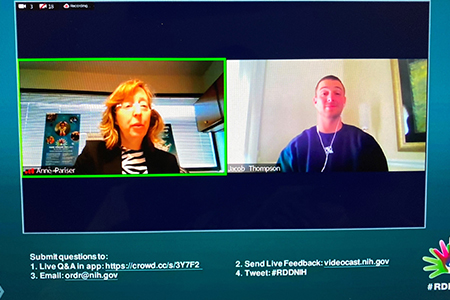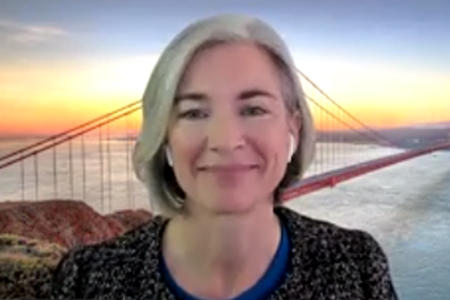
2021 Rare Disease Day at NIH: Finding Hope Within Uncertainty
April 1, 2021
Over the past decade, Rare Disease Day at NIH has brought together thousands of members of the rare diseases community on the NIH campus in Bethesda, with thousands more watching remotely. On March 1, 2021, the event was held through a virtual platform only for the first time.
“We never would have imagined 10 years ago that … we would be fighting to continue research, including rare diseases and everything else, in the midst of a pandemic,” said Francis S. Collins, M.D., Ph.D., NIH director. “But we’ve done our best to rise to the challenge.”
Co-sponsored by NCATS and the NIH Clinical Center, the annual event highlights rare diseases, the people they affect, and NIH research collaborations underway to address scientific challenges and advance new treatments. Rare Disease Day at NIH 2021 featured presentations by clinicians, scientists, industry leaders, patients and families, caregivers and advocates and more.
A Public Health Crisis
NCATS considers rare diseases as a major public health issue. Individually rare and collectively common, an estimated 30 million people in the United States have been diagnosed with one of about 7,000 identified rare diseases. Of these diseases, only about 5% have U.S. Food and Drug Administration–approved treatments.

Anne R. Pariser, M.D., director of the NCATS Office of Rare Diseases Research, and Jacob Thompson, rare disease patient and advocate, engage with audience questions during the virtual Rare Disease Day at NIH 2021 event. (NCATS)
During the meeting, former NCATS director Christopher P. Austin, M.D., reflected on the advances in understanding the biology of rare diseases he’s seen over his career. He emphasized that clinical treatments, however, have failed to keep pace with the rapid progress in research laboratories. NCATS’ mission is to bridge this gap, supporting scientific efforts and the development of operational processes to translate scientific findings into treatments for patients more effectively.
“The last year has seen a really dramatic and a historic rapidity in [the] accuracy and quality of development of therapeutics and vaccines for COVID-19 disease, and we all understand why that is so important,” Austin said. “But I think the urgency that we’ve seen in the public sector, private sector — and the public itself across our society — is the kind of urgency that we feel in the rare disease community every single day … We need to bring that same urgency to rare diseases.”
The key to addressing rare diseases, Austin stressed, is to consider them not as independent disorders but as related conditions that often reflect common underlying causes.
“We’re not focused on any one rare disease; what we’re trying to do is improve the research environment for all rare diseases,” said Anne R. Pariser, M.D., director of the NCATS Office of Rare Diseases Research.
Impacts of a Global Pandemic
The COVID-19 pandemic has profoundly affected nearly every aspect of the rare diseases world. Laboratories have faced long-term closures, and clinical trials have been canceled or placed on hold. Patient advocacy groups have transitioned to virtual platforms. The greatest impacts of the pandemic, however, have been felt by the patients themselves and their families.
Niclas Flysjö and Jessica Lindqvist first experienced the direct effects of the pandemic in early 2020. Their three young children recently had been diagnosed with GM1 gangliosidosis, a rare genetic disorder that leads to the progressive destruction of nerve cells in the brain and spinal cord.
On January 20, the children were accepted into an NIH-sponsored clinical trial. Flysjö and Lindqvist began preparing to travel from their home in Sweden to the United States. In the second week of March, however, the couple was awoken in the middle of the night with chilling news: the U.S. border was closing, and the family needed to travel immediately. Their flights were booked hurriedly, and they arrived at John F. Kennedy International Airport only 3 hours before the U.S. borders were officially closed.
At this time, the family faced a long and challenging road ahead. After reaching the NIH campus, they remained under strict quarantine for 2 weeks. The children were immunosuppressed during the course of treatment, leaving them particularly vulnerable to severe complications associated with COVID-19 infection. For 6 months, the family lived at the Children’s Inn at NIH, which provides free lodging for families participating in clinical trials.
Flysjö and Lindqvist emphasized that although the treatment’s long-term effectiveness is not yet known, they are forever grateful to the NIH for its support. “Life since our children's diagnosis has been difficult, scary, and filled with uncertainty — even more so due to the pandemic,” Flysjö said. “But we also found hope and a purpose, met lots of wonderful people who did a lot for our family, and got the chance to give our kids a treatment that might save their lives.”
Like Flysjö and Lindqvist, many rare disease patients and their families have faced uncertainty during the pandemic. The NCATS-led Rare Diseases Clinical Research Network (RDCRN) presented preliminary results from its COVID-19 research survey to better understand the dynamics of these impacts. The early findings indicate that the past year’s struggles have been felt deeply within the rare diseases community. For example, many people with rare diseases have struggled to obtain medications or some foods for specialized diets required for their treatment. Access to COVID-19 testing also represented a challenge.
“It seems that the world has received an education on disease — from research, to treatment, to advancing therapeutics, through the eyes of this pandemic — and now has a taste of what those with rare diseases often live with every day,” said Kristen Wheeden, M.B.A., executive director of the American Porphyria Foundation and co-chair of the RDCRN Coalition of Patient Advocacy Groups. “That can include frustration, fear and uncertainty, isolation and anxiety, emotional exhaustion, as well as pain. And perhaps most important of all — hope.”
Hope in New Genetic Technologies
Because most rare diseases arise from genetic mutations, advances in novel genetic technologies have provided the community with new hope for effective treatments. In recent years, the development of CRISPR genome editing has gained considerable attention. This approach could be applied therapeutically to replace an existing genetic mutation, overwriting the sequences coded by nature. CRISPR holds considerable potential for application in medicine, basic research and agriculture. The approach recently was employed successfully as a therapeutic for sickle cell disease.

Nobel laureate Jennifer A. Doudna, Ph.D., shares her perspective on the potential applications of CRISPR gene-editing technology. (NCATS)
Speaker Jennifer A. Doudna, Ph.D., who was awarded the 2020 Nobel Prize in Chemistry for her pioneering work on CRISPR, predicted that treatments for other conditions — such as diseases of the eye and muscular dystrophies — will emerge in the next several years.
The NIH is supporting several efforts to promote gene editing and gene therapy. The NIH Common Fund’s Somatic Cell Genome Editing (SCGE) program, which is coordinated by NCATS, was established to improve the efficacy and specificity of genome-editing technologies. Additionally, the NCATS-led Platform Vector Gene Therapy (PaVe-GT) pilot project is developing standardized protocols for gene therapy, with goals of making such treatments more accessible.
“The possibilities are endless,” Doudna said. “[CRISPR is] a tool that can be used not only to uncover … the genetics of disease, but it also can be used as the actual therapy. And this is not a fantasy; this is actually going on right now.”
For information on previous Rare Disease Day at NIH events, please visit the past events page.



